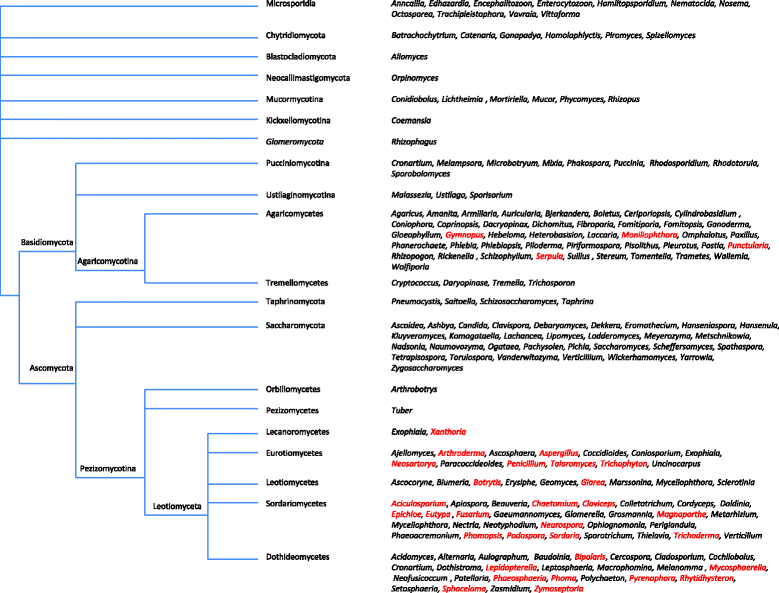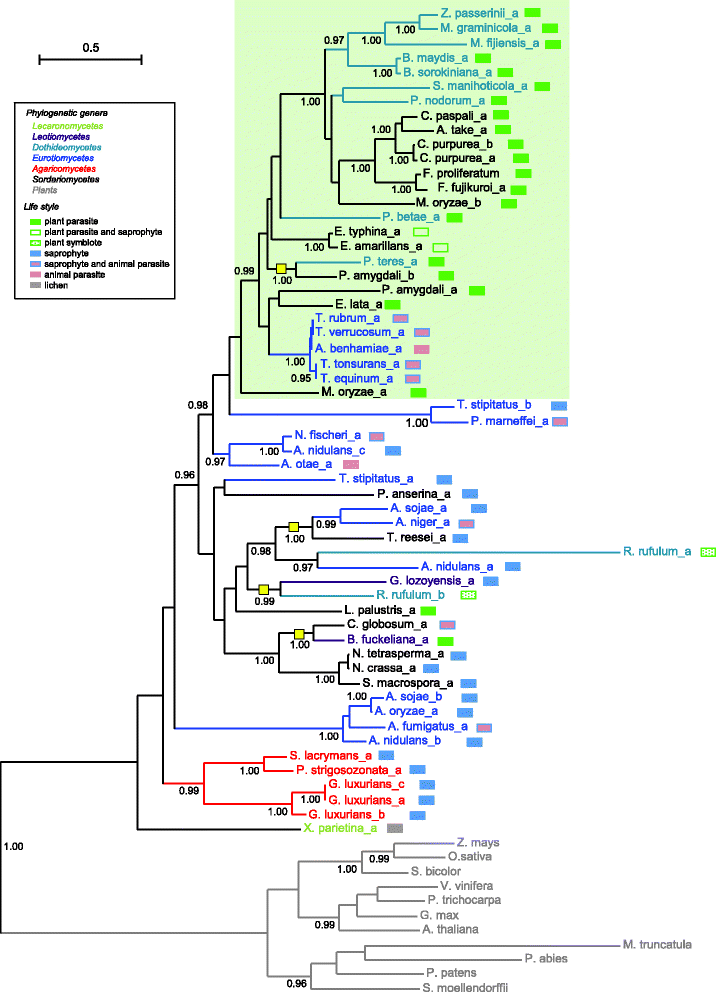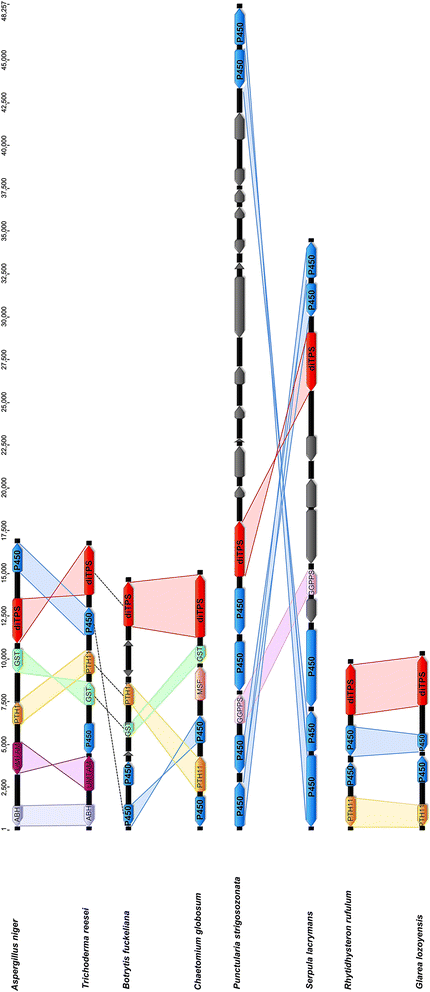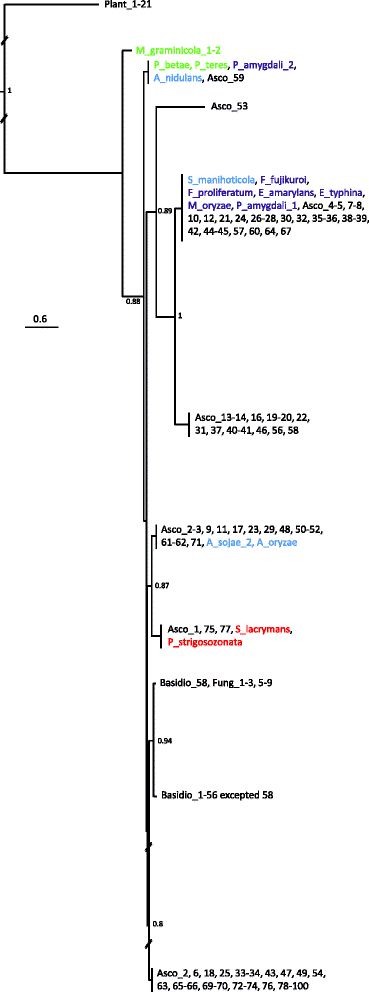Molecular and functional evolution of the fungal diterpene synthase genes
- PMID: 26483054
- PMCID: PMC4617483
- DOI: 10.1186/s12866-015-0564-8
Molecular and functional evolution of the fungal diterpene synthase genes
Abstract
Background: Terpenes represent one of the largest and most diversified families of natural compounds and are used in numerous industrial applications. Terpene synthase (TPS) genes originated in bacteria as diterpene synthase (di-TPS) genes. They are also found in plant and fungal genomes. The recent availability of a large number of fungal genomes represents an opportunity to investigate how genes involved in diterpene synthesis were acquired by fungi, and to assess the consequences of this process on the fungal metabolism.
Results: In order to investigate the origin of fungal di-TPS, we implemented a search for potential fungal di-TPS genes and identified their presence in several unrelated Ascomycota and Basidiomycota species. The fungal di-TPS phylogenetic tree is function-related but is not associated with the phylogeny based on housekeeping genes. The lack of agreement between fungal and di-TPS-based phylogenies suggests the presence of Horizontal Gene Transfer (HGTs) events. Further evidence for HGT was provided by conservation of synteny of di-TPS and neighbouring genes in distantly related fungi.
Conclusions: The results obtained here suggest that fungal di-TPSs originated from an ancient HGT event of a single di-TPS gene from a plant to a fungus in Ascomycota. In fungi, these di-TPSs allowed for the formation of clusters consisting in di-TPS, GGPPS and P450 genes to create functional clusters that were transferred between fungal species, producing diterpenes acting as hormones or toxins, thus affecting fungal development and pathogenicity.
Figures




Similar articles
-
Terpene Synthase Genes Originated from Bacteria through Horizontal Gene Transfer Contribute to Terpenoid Diversity in Fungi.Sci Rep. 2019 Jun 25;9(1):9223. doi: 10.1038/s41598-019-45532-1. Sci Rep. 2019. PMID: 31239482 Free PMC article.
-
Evidence of repeated horizontal transfer of sterol C-5 desaturase encoding genes among dikarya fungi.Mol Phylogenet Evol. 2020 Sep;150:106850. doi: 10.1016/j.ympev.2020.106850. Epub 2020 May 11. Mol Phylogenet Evol. 2020. PMID: 32438044
-
Biosynthetic gene-based secondary metabolite screening: a new diterpene, methyl phomopsenonate, from the fungus Phomopsis amygdali.J Org Chem. 2009 Feb 20;74(4):1541-8. doi: 10.1021/jo802319e. J Org Chem. 2009. PMID: 19161275
-
Reconstitution of biosynthetic machinery of fungal natural products in heterologous hosts.Biosci Biotechnol Biochem. 2020 Mar;84(3):433-444. doi: 10.1080/09168451.2019.1690976. Epub 2019 Nov 18. Biosci Biotechnol Biochem. 2020. PMID: 31738699 Review.
-
The family of terpene synthases in plants: a mid-size family of genes for specialized metabolism that is highly diversified throughout the kingdom.Plant J. 2011 Apr;66(1):212-29. doi: 10.1111/j.1365-313X.2011.04520.x. Plant J. 2011. PMID: 21443633 Review.
Cited by
-
Diterpene Biosynthesis in Rice Blast Fungus Magnaporthe.Front Fungal Biol. 2022 Apr 12;3:869823. doi: 10.3389/ffunb.2022.869823. eCollection 2022. Front Fungal Biol. 2022. PMID: 37746177 Free PMC article.
-
Chromosome-Scale Genome and Transcriptomic Analyses Reveal Differential Regulation of Terpenoid Secondary Metabolites in Hericium coralloides.J Fungi (Basel). 2024 Oct 9;10(10):704. doi: 10.3390/jof10100704. J Fungi (Basel). 2024. PMID: 39452656 Free PMC article.
-
Diterpenes Specially Produced by Fungi: Structures, Biological Activities, and Biosynthesis (2010-2020).J Fungi (Basel). 2022 Feb 28;8(3):244. doi: 10.3390/jof8030244. J Fungi (Basel). 2022. PMID: 35330246 Free PMC article. Review.
-
Probing Labdane-Related Diterpenoid Biosynthesis in the Fungal Genus Aspergillus.J Nat Prod. 2017 Feb 24;80(2):328-333. doi: 10.1021/acs.jnatprod.6b00764. Epub 2017 Jan 31. J Nat Prod. 2017. PMID: 28140586 Free PMC article.
-
Genomic and transcriptomic analyses reveal differential regulation of diverse terpenoid and polyketides secondary metabolites in Hericium erinaceus.Sci Rep. 2017 Aug 31;7(1):10151. doi: 10.1038/s41598-017-10376-0. Sci Rep. 2017. PMID: 28860534 Free PMC article.
References
MeSH terms
Substances
LinkOut - more resources
Full Text Sources
Other Literature Sources

